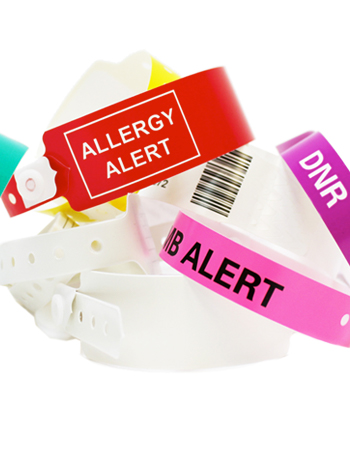Patient Identification Band: Making Sure Compliance and Security in Medical care
Patient Identification Band: Making Sure Compliance and Security in Medical care
Blog Article
Enhancing Patient Treatment With Efficient Recognition Bands
The application of effective identification bands is a critical aspect in boosting patient care within healthcare setups. As the landscape of client recognition advances, one have to think about the ramifications of these systems on general health care delivery and client end results.
Relevance of Person Recognition
Guaranteeing precise client identification is crucial in health care setups, as it directly impacts the safety and security and top quality of treatment supplied. Misidentification can cause major mistakes, including administering the wrong medicine, doing incorrect treatments, or miscommunicating important individual info. Such errors not only threaten client security yet can likewise lead to lawful ramifications and reduced rely on healthcare systems.
Efficient individual identification is basic to establishing a safe and secure setting where individuals receive suitable and individualized care. It promotes the exact paperwork of case histories, allergies, and treatment strategies, ensuring that medical care carriers have accessibility to vital information at all times. Furthermore, durable identification protocols aid simplify communication amongst clinical team, enhancing partnership and reducing the threat of mistakes.

Types of Identification Bands
Recognition bands play an essential function in preserving exact person documents and enhancing safety within health care environments. Different sorts of identification bands are made use of to satisfy the specific needs and demands of different patient populaces.

An additional type is the ankle joint band, which is particularly useful for babies and infants, ensuring that recognition remains intact even throughout treatment treatments. Specialty bands, such as those for allergy alerts or drop risk indicators, give additional layers of safety by attracting prompt attention to vital client conditions.
Lately, digital recognition bands have gotten appeal, including barcodes or RFID innovation that can be scanned to rapidly get client data. These bands enhance operations and decrease the danger of human mistake throughout patient recognition processes.
Advantages of Reliable Recognition
Effective identification of people via making use of identification bands adds significantly to total person security and care high quality. By ensuring that each person is precisely recognized, health care carriers can efficiently match medical treatments and treatments to the appropriate person, decreasing the threat of mistakes. This is especially important in atmospheres with high patient turn over, where the capacity for misidentification is better.
In addition, reliable recognition bands boost interaction amongst health care teams. Accurate and clear client identification cultivates cooperation and guarantees that all team members are mindful of a person's certain demands and case history. This communication is crucial for supplying collaborated care, specifically in emergency situation circumstances where time is critical.

Inevitably, effective identification through making use of recognition bands not only safeguards clients but also advertises a culture of safety within health care centers (Patient Identification Band). By prioritizing exact identification, healthcare organizations can improve end results and improve the total client experience
Implementing Recognition Solutions
While the value of individual recognition is well acknowledged, the implementation of robust recognition systems poses a complex obstacle for healthcare companies. Establishing efficient recognition systems needs a detailed strategy, incorporating technology, personnel training, and procedure combination.
First, companies need to select proper identification technologies, such as barcode scanning, RFID, or biometric systems. Patient Identification Band. These innovations should be reviewed based on Read Full Article expense, use, and compatibility with existing facilities. A pilot program can help recognize potential problems before full-scale application
Next, detailed training for team is essential. All employees must recognize the relevance of precise client identification and excel in making use of the selected modern technologies. Regular training updates and analyses can enhance finest techniques and ensure continued compliance.
Additionally, medical care organizations must develop standard treatments for patient identification throughout all departments, enhancing and minimizing inconsistencies interaction. Regular audits can aid determine voids in adherence to these protocols.

Inevitably, an efficient execution of recognition systems not just boosts individual safety however also cultivates a culture of responsibility and diligence within health care settings, making certain regular and reliable individual treatment.
Future Trends in Client Recognition
Innovations in modern technology are readied to revolutionize individual recognition practices in medical care setups. The helpful hints integration of biometric identification approaches, such as fingerprinting and face recognition, is expected to enhance precision and protection. These innovations can significantly lower the danger of misidentification, making certain that people receive the right treatments and drugs.
In addition, the application of blockchain modern technology for individual records is acquiring traction. This decentralized technique can offer a secure and tamper-proof approach for managing individual you could try these out identities, thus streamlining accessibility to essential information across different healthcare companies.
Another fad is the enhancing use mobile wellness applications that leverage QR codes for individual recognition. These applications permit real-time updates and simple access to individual information, equipping medical care specialists to make informed decisions quickly.
In addition, expert system (AI) is poised to play a key function in evaluating individual identification information, determining patterns, and anticipating possible recognition mistakes prior to they occur.
As these technologies progress, they guarantee not just to improve client safety and security yet likewise to boost the total effectiveness of medical care distribution systems. Welcoming these technologies will be important for future-proofing patient care practices.
Conclusion
Finally, effective recognition bands are crucial for boosting person safety and security and care high quality within health care settings. By reducing the risks related to misidentification, these bands assist in precise and prompt info access, inevitably enhancing communication amongst doctor. The application of robust recognition systems not just promotes a culture of safety however also placements health care establishments to adjust to future fads in client identification innovation, making sure ideal outcomes for clients in varied medical settings.
As the landscape of individual recognition evolves, one need to take into consideration the effects of these systems on total health care delivery and patient end results.Efficient individual recognition is basic to establishing a safe setting where clients get suitable and individualized care. Ultimately, prioritizing reliable client recognition methods not only promotes a society of safety and security but likewise contributes to improved individual end results and total contentment with medical care services.
Effective identification of people via the use of recognition bands adds considerably to total individual safety and security and care high quality. The application of durable identification systems not only promotes a society of security however additionally positions medical care establishments to adjust to future trends in client recognition innovation, guaranteeing ideal end results for patients in diverse medical atmospheres.
Report this page